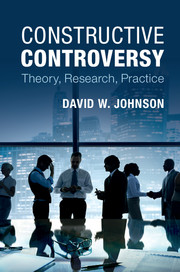Book contents
- Frontmatter
- Contents
- List of figures
- List of tables
- Acknowledgments
- 1 Underlying foundations of constructive controversy
- 2 The nature of constructive controversy
- 3 Theory of constructive controversy
- 4 The processes of constructive controversy and concurrence seeking
- 5 The outcomes of constructive controversy
- 6 Conditions mediating the effects of constructive controversy
- 7 Constructive controversy and decision making
- 8 Constructive controversy in education
- 9 Constructive controversy and political discourse in democracies
- 10 Constructive controversy, creativity, and innovation
- 11 Constructive controversy and building and maintaining peace
- 12 Conclusions
- References
- Index
7 - Constructive controversy and decision making
Published online by Cambridge University Press: 05 June 2015
- Frontmatter
- Contents
- List of figures
- List of tables
- Acknowledgments
- 1 Underlying foundations of constructive controversy
- 2 The nature of constructive controversy
- 3 Theory of constructive controversy
- 4 The processes of constructive controversy and concurrence seeking
- 5 The outcomes of constructive controversy
- 6 Conditions mediating the effects of constructive controversy
- 7 Constructive controversy and decision making
- 8 Constructive controversy in education
- 9 Constructive controversy and political discourse in democracies
- 10 Constructive controversy, creativity, and innovation
- 11 Constructive controversy and building and maintaining peace
- 12 Conclusions
- References
- Index
Summary
INTRODUCTION
Theory may inform, but practice convinces.
George Bain (1881–1968), Scottish artistA large pharmaceutical company faced the decision of whether to buy or build a chemical plant (The Wall Street Journal, October 22, 1975). To maximize the likelihood that the best decision was made, the president established two advocacy teams to ensure that both the “buy” and the “build” alternatives received a fair and complete hearing. An advocacy team is a subgroup that prepares and presents a particular policy alternative to the decision-making group. The “buy” team was instructed to prepare and present the best case for purchasing a chemical plant, and the “build” team was told to prepare and present the best case for constructing a new chemical plant near the company's national headquarters. The “buy” team identified over 100 existing plants that would meet the company's needs, narrowed the field down to 20, further narrowed the field down to 3, and then selected 1 plant as the ideal plant to buy. The “build” team contacted dozens of engineering firms and, after four months of consideration, selected a design for the ideal plant to build. Nine months after they were established, the two teams, armed with all the details about cost, (a) presented their best case and (b) challenged each other's information, reasoning, and conclusions. From the spirited discussion, it became apparent that the two options would cost about the same amount of money. The group, therefore, chose the “build” option because it allowed the plant to be conveniently located near company headquarters. This procedure represents the structured use of constructive controversy to ensure high-quality decision making.
In this chapter the application of constructive controversy in decision-making situations is explored. Decision making will first be defined, the constructive controversy procedure for decision making is then described, and the relevance of constructive controversy for thoughtful and considered decision making will then be described.
- Type
- Chapter
- Information
- Constructive ControversyTheory, Research, Practice, pp. 119 - 129Publisher: Cambridge University PressPrint publication year: 2015



